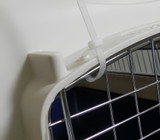Airline Kennels Safety Features-Details
Airline Safety Features Plastic Pet Cat Carrier Dog Kennels & Crates
Getting ready to shop for a new Dog Airline Kennel, Carrier or Crate? You might find this post handy, it describes the new safety features that are available and how exactly they work to keep your airline traveling pets safer. In this post we will examine some of the NEWEST Dog Airline Kennels and Crates Safety Features in Detail.
 |
|
 |
|
 |
|
 |
|
 |
|
 |
|
 |
|
 |
|
PetsOnAirplanes Articles
SERVICE ANIMAL TSA INSPECTION
This video highlights the challenges of navigating airport travel with a Service/Guide Dog or E...
Approved vs Banned Pet Carriers Kennels Guide
WHAT is an Airline Approved Pet Carrier or Kennel? At DryFur, we aim to guide pet owners in th...
Airline Pet Carrier Bags, Safety Features - Detail
Check out the Latest Soft Pet Carrier Safety Features Getting ready to shop for a new Airline...
Airline Kennels Safety Features-Details
Airline Safety Features Plastic Pet Cat Carrier Dog Kennels & Crates Getting ready to shop for...
Biggest Mistakes to avoid Shipping a Pet By Air
10 Biggest Mistakes to Avoid when traveling by air with pets Shipping your pet in an old worn out...
Airline Travel Tips for Snub Nosed Pets
The A, B, C’s of Snub Nosed (Brachycephalic) Pet Flight Safety With emotion, we at DryFur.com have b...







